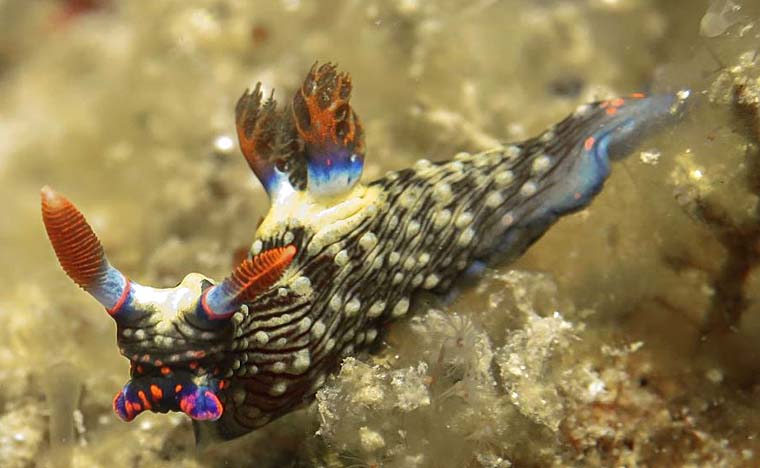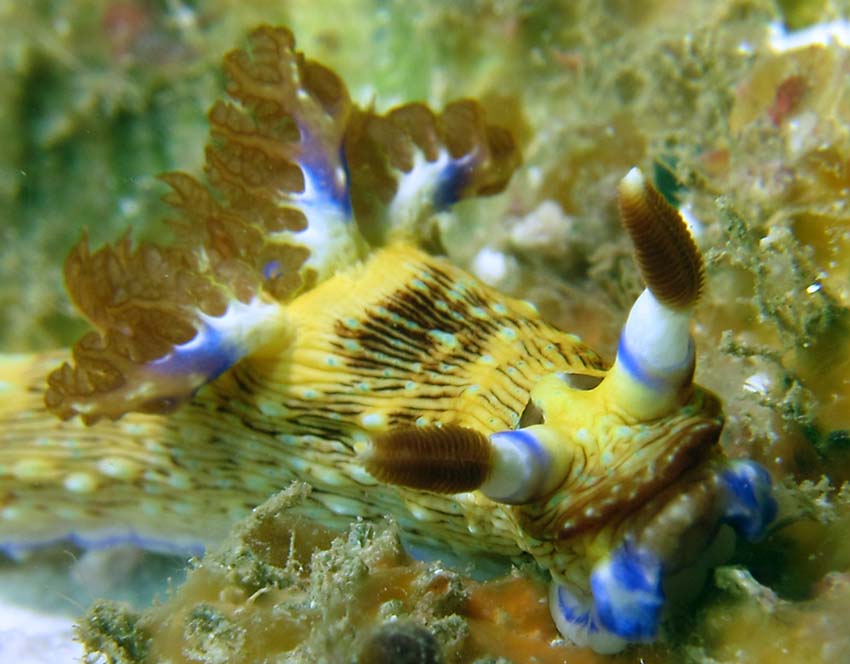This species has been observed on Mayotte and Madagascar Islands
The animals are characterised by the presence of a cross-like mark white to pale yellow between the rhinophores The entire body surface has a pattern of longitudinal wrinkles with small irregular spots (or pustules) scattered over the notum and both sides of the body. The rhinophores are orange-reddish with bluish- white pigmentation at their base The gill branches are reddish brown with orange-reddish tips. The base is white or pale yellow with electric blue above. |
 |
|
| Showing species characteristics... | Photo
Matthias Deuss |
|
Remarks :
N. livingstonei according Nathalie Yonow and according Hsini Lin Nembrotha sp. 5 in NSSI, Nudibranch & Sea Slug Identification, Indo-Pacific, Gosliner, Valdés & Behrens, 2015, may be a color variation of N. livingstonei
Synonymous : (according Worms)
- No other name
Bibliographic data :
The general colour of the living animals is dark reddish brown with orange, reddish brown, green or white spots.
The entire body surface has a pattern of longitudinal wrinkles with small irregular spots scattered over the notum and both sides of the body. In some specimens the spots are strongly marked, becoming pustules, while in other specimens the spots appear as irregular patches between the wrinkles. The spots located at the end of the tail and those on the front edge are bright orange.
Specimens are very variable in colour, but all of them are characterised by the presence of the conspicuous star-shaped patch between the rhinophores.
The body is elongate and limaciform, reaching up to 55 mm in length, the posterior end of the foot is long and pointed and the head is rounded
There is a pair of large conical, perfoliate rhinophores. The rhinophores, bearing 20-25 lamellae, are completely retractile into their elongate rhinophoral sheaths.
The rhinophores are orange-reddish with bluish- white pigmentation at their base. The rhinophorical sheaths are tipped in orange and their base is also white and blue
There are five strong multipinnate, non-retractile branchial leaves. The two posterior leaves of each side share a common base.
The anus is mid-dorsal, located in the centre of the branchial circle.
The genital pore opens on the right side, midway between the rhinophores and the anterior portion of the gill.
The oral tentacles are thick and elongate with a depression at the centre of each
The foot is bordered with concentric, white (or pinkish) and bluish violet lines. But in other specimen the edge of the foot has a bright orange stripe. The foot sole is dark grey.
Nembrotha livingstonei is easily distinguishable from the remaining species of Nembrotha by the possession of the white crosslike mark between the rhinophores. However, some of the colour forms of N. livingstonei strongly resemble those of N. nigerrima (= kubaryana)
References :
Bill Rudman Seaslug site : Sea Slug Forum : Nembrotha livingstonei
Nudipixel Nembrotha livingstonei
Publications :
Allan, J. (1933). Opisthobranchs from Australia. Records of the Australian Museum, 18 : 443-450.
Pola, M., Cervera, J.L. and Gosliner, T.M. (2008). Revision of the Indo-Pacific genus Nembrotha (Nudibranchia: Dorididae: Polyceridae), with description of two new species. Scientia Marina 72(1): 145-183
Other photos of Nembrotha cf. livingstonei :
 |
Barbara Bini Madagascar,Nosy bé, 13 m, size : 30 mm
|
Matthias Deuss Mayotte, ilot de Bandrelè, 2 m, 18 December 2011, size : 50-60 mm. |
The same specimen, just for the pleasure...
|
 |
|
 |
Philibert Bidgrain There are five strong multipinnate, non-retractile branchial leaves. The two posterior leaves (2-3 and 4-5) of each side share a common base. |
Matthias Deuss Mayotte, ilot de Bandrelè, 2 m,10 February 2012, size : 20 mm. Under the same stone of the other specimen photographed during December 2011... The genital pore (a) opens on the right side, midway between the rhinophores and the anterior portion of the gill. |
 |
More photos from Indian Ocean
If you have taken a photo of this species in Reunion, Mayotte, Mauritius or Madagascar Islands, please Contact us...